Poker rules can be confusing at times. You might think you know them all, but then during your play with friends, you come upon a situation, and you are unsure of the rule. One such scenario that might confuse you is when you see two players having a flush. So who wins? The answer is pretty clear to an experienced player like myself, and after reading this article, it will be simple for you to know next time also.
A player with the highest flush rank wins. If both players have the flush of the same rank, then the pot would get split between them. This, of course, holds true only if no one else has a card combination higher than a flush.
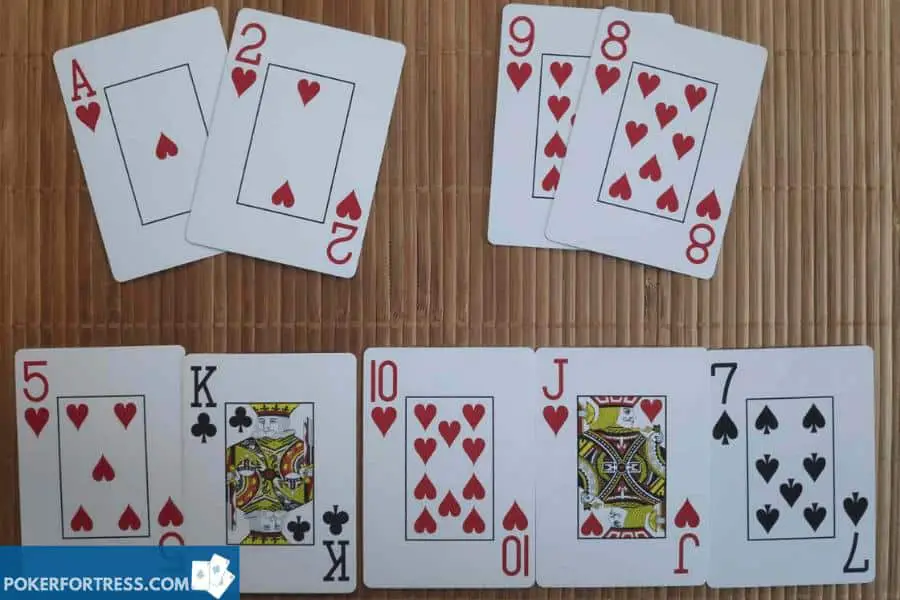
Flush is a very powerful hand in poker. You are expected to dominate your opponents very often once you hit it. Therefore it is no surprise it doesn’t usually happen that you get to hit one. You will hit a flush only 0.2% percent of the time. There is a common misconception that a flush is easier to hit, but in fact, you will hit flush half as often as you hit a straight (0.4% chance to hit a straight). And because a flush is harder to hit, your winrate with flush will be higher than with a straight.
It is very crucial to play the right hands to maximize your chances of hitting a flush.
Best cards to hit a flush are high suited hands. AK suited is, of course, the best one to have, followed by AQ suited. Your winrate will still be high with all of the suited broadway hands (JTs, QTs, KTs, ATs, QJs, KJs, AJs, KQs, AQs, and AKs).
Of course, you can hit a flush with a non-suited hand also, but having a suited hand with increase your chances to hit a flush by a lot.
Bigger cards are better for hitting a flush
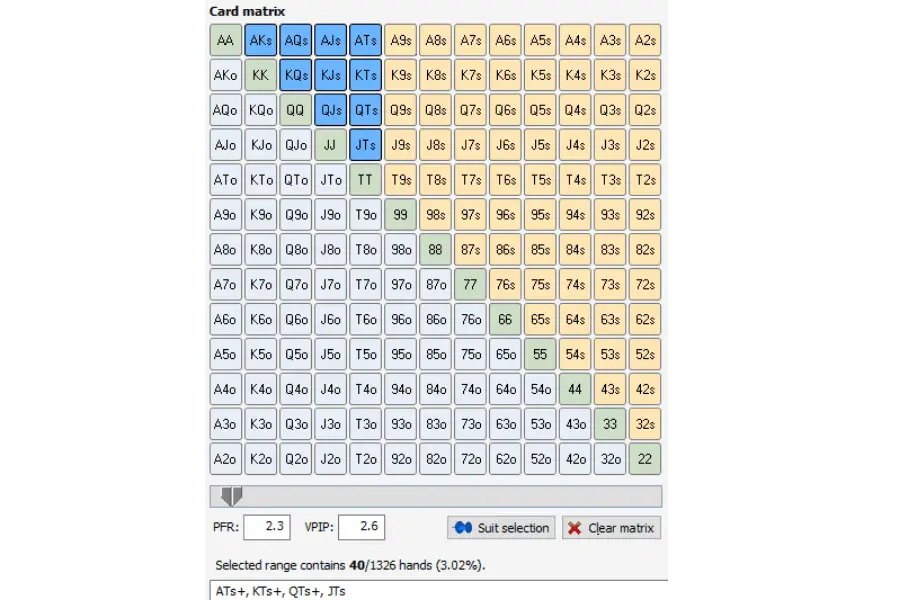
Why is a high double suited hand a lot better than the lower double suited hand? If you play AKs, AQs, or AJs, you will always have the nut flush (ace-high flush) when you hit a flush compared to 98s. A flush is a very strong hand, no matter how high your flush is. It is tough to lay down a flush, even to strong bets.
If you hit the nut flush on 5hKcThJh7s board with AhQh and your opponent has 8h9h, it will be very tough of him to fold his flush (AQTJ5 high flush wins against JT895 high flush because it has higher ranking cards). It will also be very tough for you to hold a low flush when you are facing bets, after all, you beat many hands that are willing to bet – all sets, two pairs, some smaller flushes, and bluffs.
Therefore you must be on the winning side of a flush as often as possible. And big suited cards do exactly that.
Please note, due to the little chance of having a straight flush of 0.0014%, I just assume that Ace-high flush is the nut flush, and an opponent doesn’t have a straight flush, which would beat our ace-high flush.
One exception – When the bigger cards are not always better
There is one situation where having AKs is not optimal. It only matters when you hit a flush. In such a scenario, I would rather have any other ace-high flush but the AK high flush. That way, I can know that someone else might be holding a 2nd nut flush (K high flush) as I don’t hold the K myself. Some players might be folding lower flushes, but almost no one folds 2nd nut K high flush. And nobody can beat me anyway if I hold the A high flush in my hand.
The chance to hit a flush is already low, and it happens even less often that someone has second nut flush. In all the other scenarios, it is better to have AK than AQ or lower, as our kicker is very valuable. This is also the reason that my winrate with AKs is still a lot higher than with AJs. Most of the time, when we hit a flush, our opponent will not have a flush.
But the times when you see two players showing a flush do happen and it is important to distinguish from 3 possible scenarios:
- One person has a lower flush, and another person has a higher flush
- Both players have a flush of the same rank
- One player has a straight flush (with lower cards), and another player has a higher flush, but just a flush.
Higher vs. Lower Flush
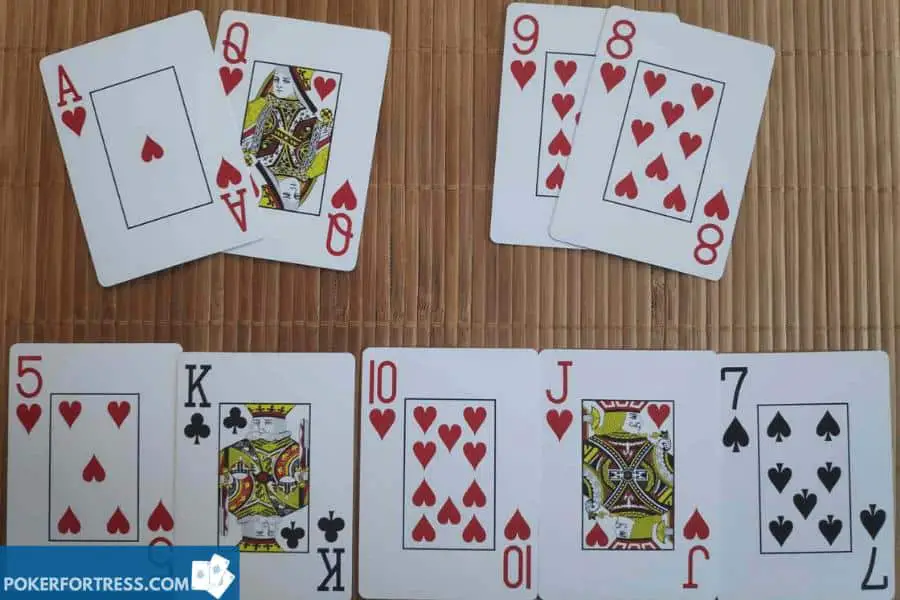
The rules of poker are simple. A player that has a higher flush will win the hand. It doesn’t matter if both players have a flush; it only matters who has the highest flush.
The value of the flush goes from lowest possible flush 23457 of the same suit, and not 23456 as this would also give us a straight flush, which is better than a normal flush. The value of flush goes all the way up to AKQJ9 of the same suit, and this is the biggest flush possible without having the strongest hand in poker – royal flush (AKQJT of the same suit).
The highest flush beats not only all the lower flushes that will not be folding to our huge bets, but it also beats all sets (trips), two pairs, and pairs.
If you don’t have the nut flush yourself (highest possible flush, depending on the board), then chances are someone else can have it. Scenarios where you have 2nd nut flush, and someone else holds the nut flush will happen, and you will pay him off. This will reduce your winrate. But all the other times you are up against worse hands you will make a lot of money. Any flush is a great hand to have as it beats so many other worse hands.
Who wins if both players have a flush of the same rank
In the case when both players have the same flush at showdown, and no one else has a better hand than this flush, then the pot would get split between them. First, the rake would get deducted from the pot, and afterward, the pot gets equally split.
Who wins if there is a flush on the table?
Scenario, where both players have the flush of the same rank, is only possible if a flush is present on the table. There is no other option, as that is the only way that both players have all 5 cards of the same rank and same suit.
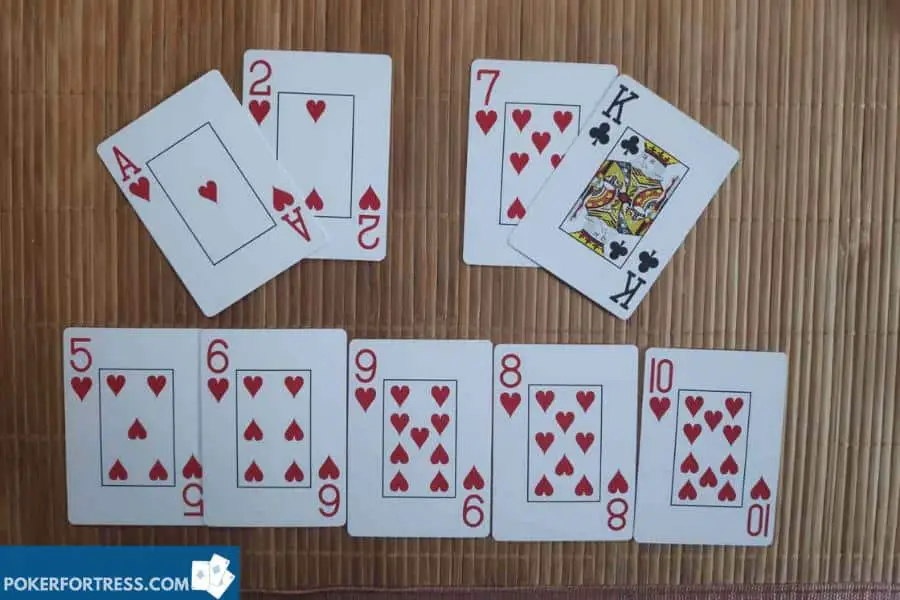
In my poker career (more than 5 million hands played online), I have seen quite some flushes on the board. A few scenarios are possible:
- Nobody has a stronger hand than the flush on the board: When nobody has a higher card of the same suit in the hole cards (in their hand) at showdown, then the pot would get equally split among the players that are still involved in the hand at showdown. Of course, if you fold before the showdown, then you give up on your hand and can’t win the pot (get equal share in this scenario).
- Someone has a better hand: If there isn’t a royal flush on the board, then chances are some player can have a bigger flush. Remember, in poker, the player that has the best 5 card combination wins. So on a 5689T all hearts, any player having J of hearts or higher still beats 5689T flush. But if someone has 7 of hearts, then that player will have the better nuts. As 6789T of hearts will give him a straight flush and the better hand combination. If someone would hold QhJh they would have the absolute nuts (QJT98 high straight flush).
Straight flush vs. Ace-high flush
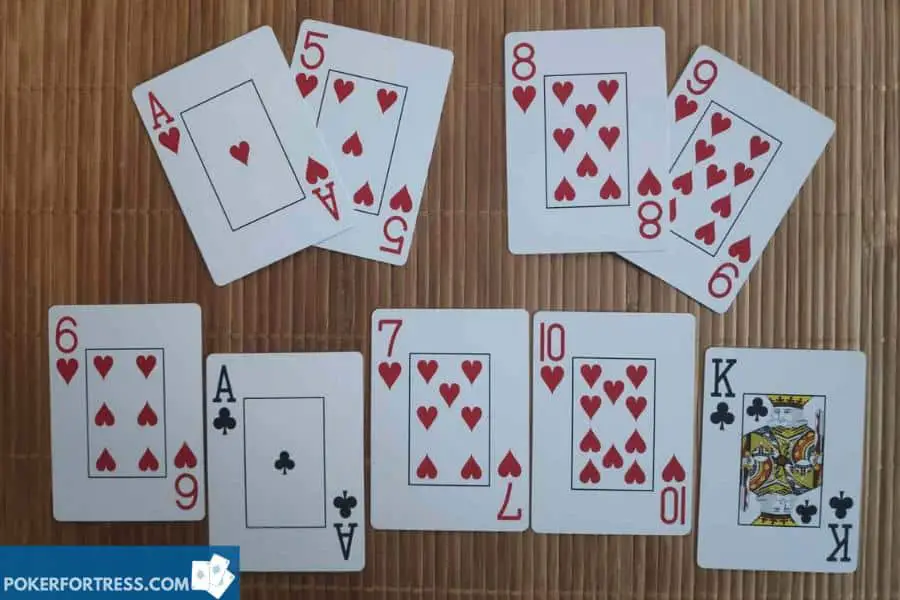
If, by any chance, you come upon a situation where one player has a straight flush, and another player has an ace-high flush, then the rules are simple here also. A straight flush is a better hand and wins against any other non-straight flush and against all lower straight flushes (if both players have a straight flush, then the one with higher straight flush wins).
You will hit a straight flush once roughly every 72,000 hands. When on the other hand, you will hit a flush once every 508 hands. So it makes sense that a straight flush wins.
Related Articles:
- Why is flush worth more than a straight?
- Is a flush or a straight more likely to hit?
- A flush beats 3 of a kind. Here is why
Conclusion
Now you know of all the possible scenarios where two players might have the flush. You know correctly who wins and when the pots get split. I am sure there will be no more confusion next time when you see two players have hit a flush.



